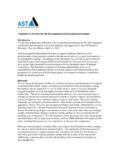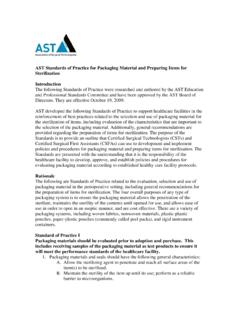Transcription of Section 03 - Guidelines for Cleaning, Disinfection ...
1 Title: Guidelines for cleaning , Disinfection and Sterilisation Page 1 of 28 Date: January 2015 Version: Author: Infection Control Team Guidelines for cleaning , Disinfection and Sterilisation of Patient Care Equipment: Staff Responsibilities Printed copies must not be considered the definitive version DOCUMENT CONTROL POLICY NO. 8 Policy Group Infection Control Committee Author Infection Control Team Version no. Reviewer Infection Control Team Implementation date January 2015 Scope (Applicability) NHS Dumfries and Galloway Board-wide Status Final Approved Document Next review date January 2017 Approved by Infection Control Committee Last review date: January 2015 Title: Guidelines for cleaning , Disinfection and Sterilisation Page 2 of 28 Date: January 2015 Version: Author: Infection Control Team Contents 1.
2 Purpose .. 3 2. Introduction .. 3 3. Principles of decontamination .. 3 5. Good practice points .. 5 7. Inspection and Packaging .. 7 8. Storage and Transportation .. 7 10. Traceability of Invasive Medical Devices .. 8 11. Record Keeping for Invasive Medical Devices .. 8 12. Training .. 8 13. Transmissible Spongiform Encephalopathies (TSE s) .. 8 14. Acquisition and Procurement .. 9 Appendix 1 A-Z Index for decontamination of reusable communal patient equipment (Ward/Dept Environment).
3 10 Appendix 2 - cleaning Responsibilities .. 18 Title: Guidelines for cleaning , Disinfection and Sterilisation Page 3 of 28 Date: January 2015 Version: Author: Infection Control Team 1. Purpose The purpose of Guideline is to promote the knowledge of cleaning and Disinfection procedures to enhance patient and staff safety. It provides instruction for the most appropriate and safe methods of decontamination of the environment and commonly used shared patient care equipment (communal) (Appendix 1) and staff roles and responsibilities (Appendix 2).
4 2. Introduction Micro-organisms can be transmitted to people from instruments, equipment and/or the environment. Where a piece of equipment is used for more than one patient (communal) it must be decontaminated following each and every episode of use and prior to being sent for service or repair, to ensure the safety of both patients and staff. The level of decontamination required is dependent on what the equipment is used for and the level to which it has been contaminated. The term decontamination refers to a process, which removes or destroys contamination.
5 Consequently, micro-organisms (or other contaminants) are prevented from reaching a susceptible site, in sufficient numbers necessary to initiate infection or any harmful response. Further advice on the Safe Management of Care Equipment can be found in the National Infection Prevention and Control Manual Chapter 1 (Standard Infection Control Precautions) 3. Principles of decontamination decontamination is a process (or combination of processes), which removes or destroys contamination and thereby prevents micro-organisms or other contaminants reaching a susceptible site in sufficient quantities to cause infection or other harmful response.
6 It is important to establish the differences between cleaning , Disinfection and sterilisation, which are used in the process of decontamination . Title: Guidelines for cleaning , Disinfection and Sterilisation Page 4 of 28 Date: January 2015 Version: Author: Infection Control Team cleaning The physical removal of contaminants including dust, soil and organic matter, along with a large proportion of micro organisms. Thorough drying following cleaning will cause a further reduction. This is the first and most important step in any decontamination process.
7 Disinfection Utilising heat or chemicals to reduce the number of viable micro- organisms to a level which is not harmful to health (but not all viruses and/or bacterial spores) Sterilisation Renders the object free from viable micro-organisms, including bacterial spores and viruses The decontamination process required is commonly categorised as one of three levels. Risk Application Recommendation Low Items in contact with healthy skin or mucous membranes or not in contact with patient cleaning Medium Items in contact with intact skin, particularly after use on infected patients or prior to use on immuno-compromised patients, or items in contact with mucous membranes or body fluids Disinfection High Items in close contact with a break in the skin or mucous membrane or introduced into a sterile body area.
8 Disinfection or sterilisation. decontamination to be undertaken in a facility approved in conjunction with the Infection Prevention and Control Team Note: Some high-risk medical devices are not able to be heat sterilised and require high level Disinfection between patients use fibre-optic endoscopes. Title: Guidelines for cleaning , Disinfection and Sterilisation Page 5 of 28 Date: January 2015 Version: Author: Infection Control Team 4. Single Use/Single patient use equipment Single use means that item is to be used once and then discarded.
9 It is essential that single use devices are not decontaminated. Single use items/products are identified by the following symbol. Single patient use means that the item can be used more than once on the same patient after it has been decontaminated. It must not be used on another patient. 5. Good practice points cleaning Automated processes are preferable to manual processes carry out cleaning in a designated dirty area where possible and avoid splashing wear appropriate personal protective equipment (PPE) , gloves, plastic apron and eye protection - even if an ultrasonic bath is used use freshly prepared detergent, diluted as per manufacturer s instructions never pre-dilute detergents and store them after cleaning , rinse items thoroughly with water (wipe electro medical equipment do not immerse)
10 Dispose of cleaning solution via sluice hopper or equipment sink - not in clinical wash hand basin. Disinfection only use approved disinfectants use scrupulously clean containers only wear appropriate PPE ensure thorough pre- cleaning of items prior to Disinfection never use chemical Disinfection when sterilisation is required or when cleaning alone is adequate ensure correct measured dilution never pre-dilute disinfectants and store them ensure items are immersed in disinfectant, the fluid entirely covering articles and penetrating into all crevices, including the insides of tubes ensure the recommended exposure time is Title.






